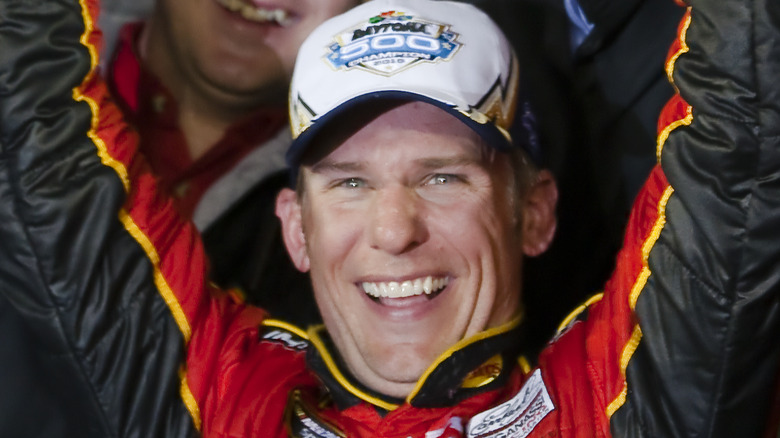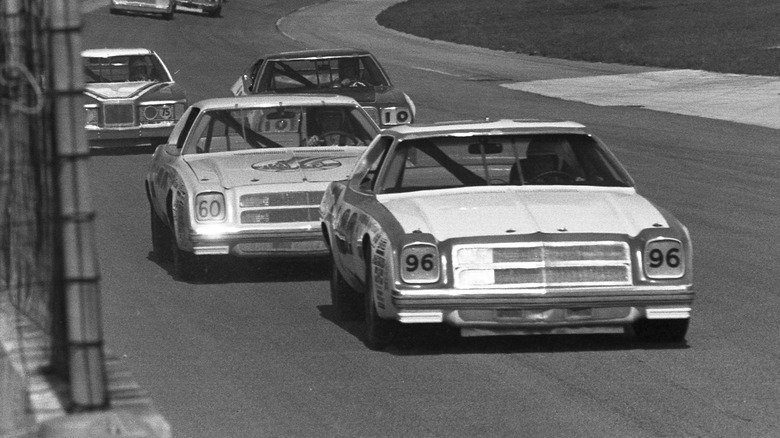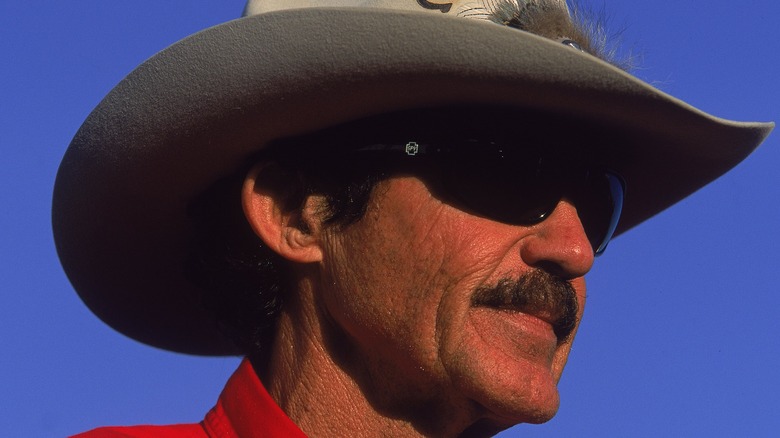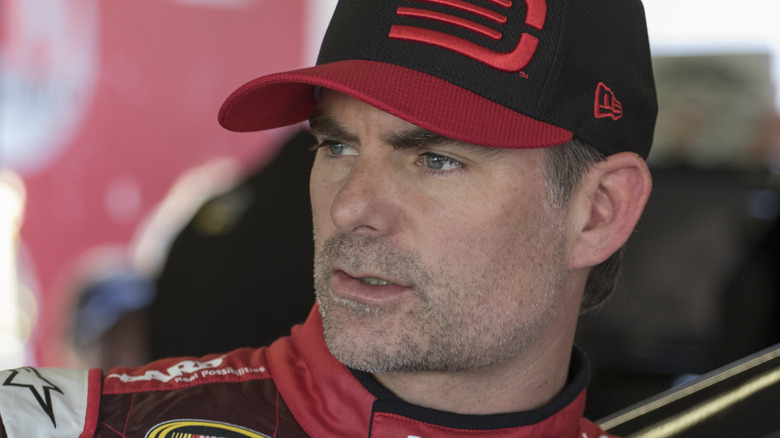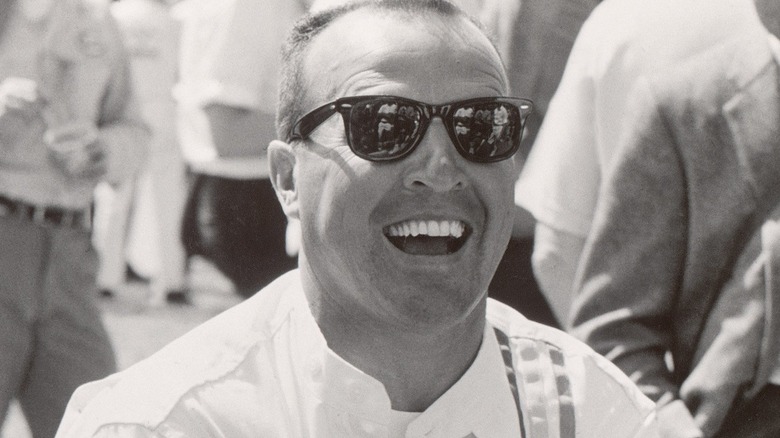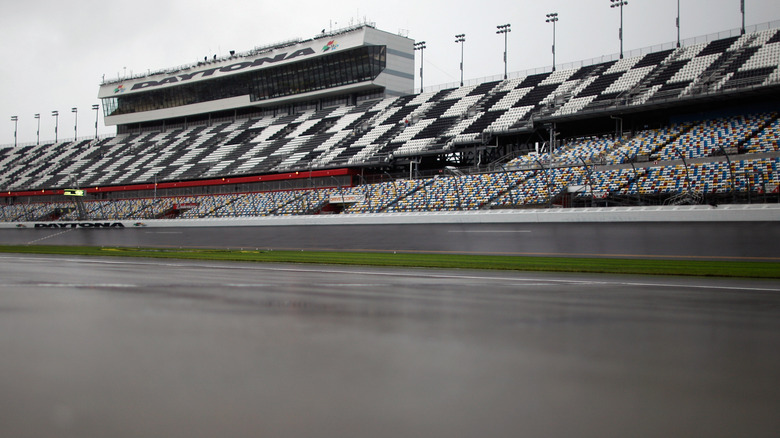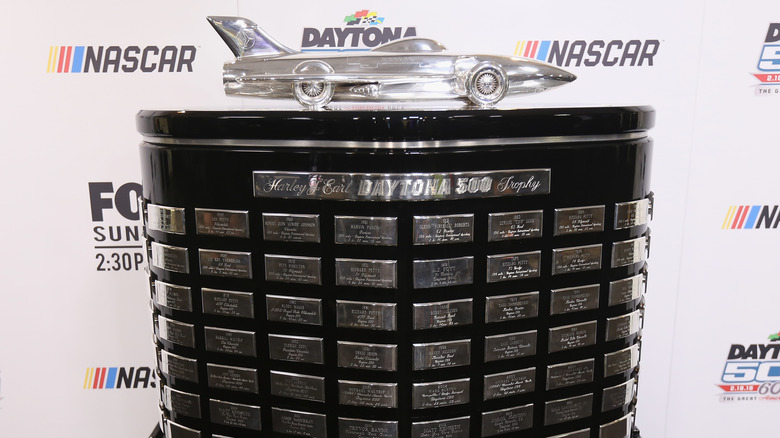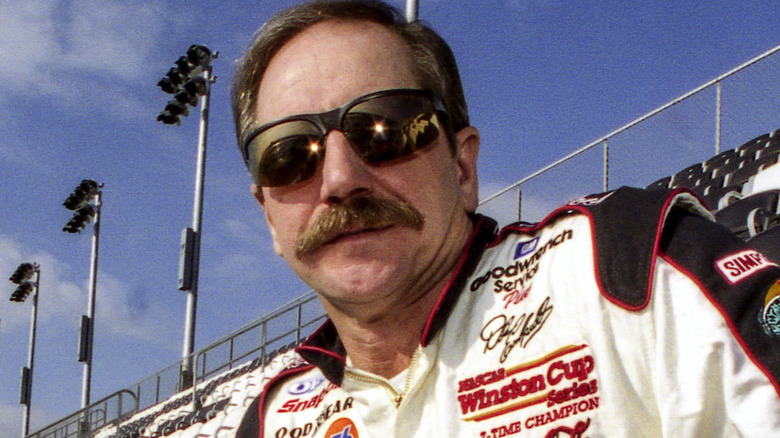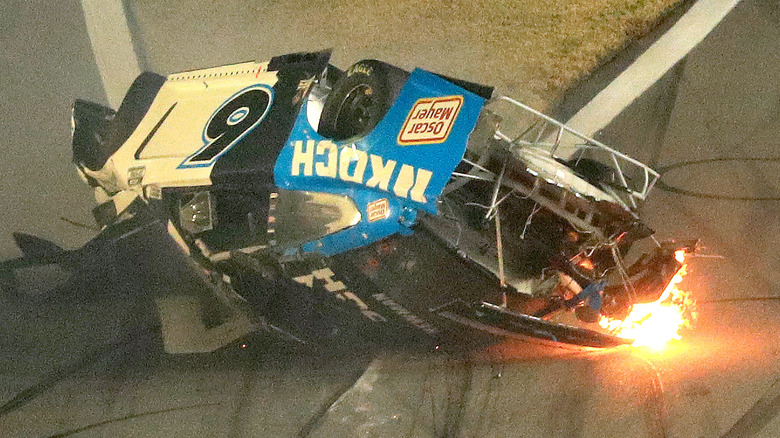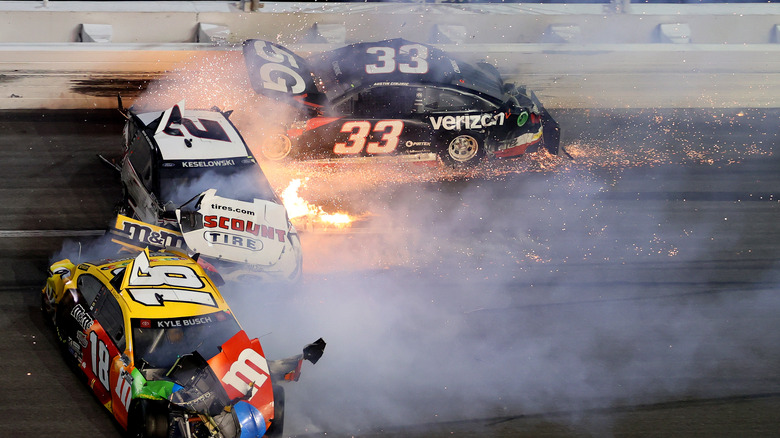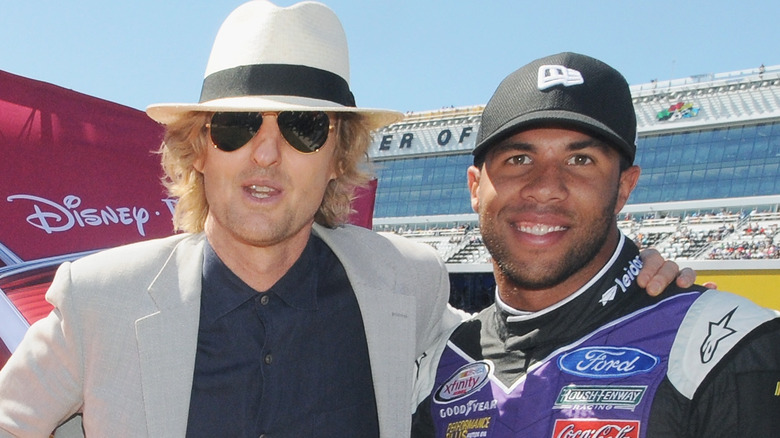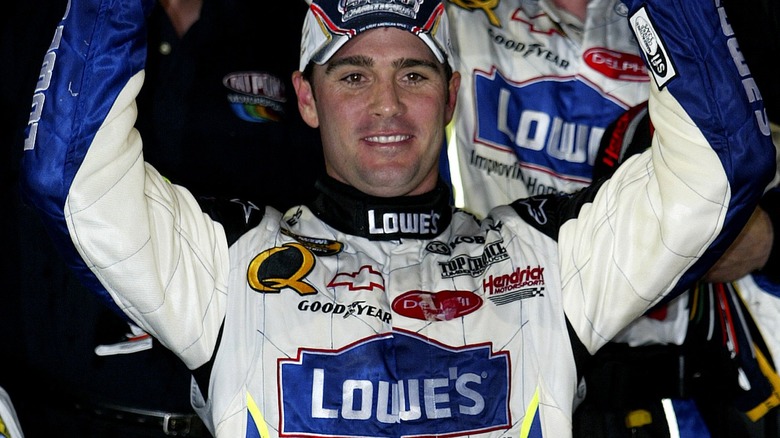The Untold Truth Of The Daytona 500
February offers an embarrassment of riches for fans of major American sports. In addition to the festivities surrounding football's spectacular Super Bowl and basketball's NBA All-Star Game, the shortest month also marks the beginning of the NASCAR season, and the premier stock car racing association opens in a big way with the illustrious Daytona 500.
Held annually at the Daytona International Speedway in Florida since 1959, as per Britannica, the 200-lap race is a day-long spectacular of high-speed, high-stakes, high-purse thrills, chills, and spills as state-of-the-art automobiles driven by the most skilled and agile drivers around compete for motorsport glory. The list of Daytona 500 winners is virtually identical to a list of NASCAR's all-time greats, with sports-transcending household names like Richard Petty, Bobby Allison, Jeff Gordon, and Dale Earnhardt among those who have had a checkered flag waved by their windshields and held the Harley J. Earl Trophy high while being showered with champagne.
It's a hallmark of sports with a long, colorful, and exciting history. Get on track to know everything there is to know about the Daytona 500.
Before the Daytona 500, Daytona itself was a racing hotspot
Each February, the Daytona 500 takes place at the Daytona International Speedway, a facility that can accommodate more than 100,000 fans. But long before the NASCAR speedway was built in 1958, as per the NASCAR website, the Daytona, Florida, area was a hotbed of early, formative auto racing. As early as 1905, when cars were a new and curious novelty, daring drivers raced them right next to the ocean on a road course consisting of hard beach sand and the nearby highway, according to Forbes. Beyond races, land speed records were attempted at Daytona, and both drew tourists to sunny Florida during the months where it was cold and wintry elsewhere on the eastern seaboard.
The car racing culture helped build up Daytona as a vacation destination, and in 1938, Bill France, a Washington, D.C. transplant who moved to Daytona to open an auto repair shop, got the job to run the beach race. According to Forbes, in July 1949, the event attracted 5,000 fans, and in 1950, France — by then the founder and head of NASCAR — moved it to February, bringing in a crowd of 9,500.
In 1959, the race was held at the Daytona International Speedway for the first time. Johnny Beauchamp was declared the winner, edging out Lee Petty, who, according to History, protested the outcome. With news photographs as proof, Petty showed that he had actually crossed the finish line before Beauchamp, and three days after the race, Petty was declared the winner.
The 1979 Daytona 500 changed everything
In 1979, the Daytona 500 fell on Presidents Day weekend, as it often does. During that same timeframe, according to the Orlando Sentinel, a historic winter storm covered large swaths of the East Coast of the United States in snow that Sunday, leaving tens of millions stuck inside with not much to do. Many chose television, and with little more than three channels from which to choose in those pre-cable and pre-streaming days, many homebound Americans decided to sample the Daytona 500 on CBS, airing live and in its entirety for the first time, no longer presented as a series of highlights or after-the-fact on showcase shows like ABC's "Wide World of Sports," according to the Los Angeles Times. The 1979 Daytona 500 was the first NASCAR race aired live on American TV period, and the event was so compelling and exciting that it scored huge ratings only occasionally matched or exceeded and is credited with transforming NASCAR into a major spectator sport virtually instantly.
In the final lap of the race, drivers Donnie Allison and Cale Yarborough were involved in an accident, allowing Richard Petty to zoom into the lead and nose out a win, an exciting moment capped by a post-race infield fist-fight between Yarbrough and Allison's brother, driver Bobby Allison. As the Los Angeles Times notes, the 1979 Daytona 500 amassed a 10.5 rating, equal to more than 15 million viewers, a number topped by only four other Daytona races over the next four decades.
How the race became one of the most important races in the world
The Daytona 500 is easily the most famous and arguably the most illustrious race in NASCAR's extensive calendar. It's also the rare championship-level event that starts a major sports association's season, rather than capping one, as is the case with comparable things like the World Series, Super Bowl, or Stanley Cup.
Raced since 1959, it wasn't until 1982, according to Forbes, that points were awarded at the Daytona 500 to determine the season's overall winner months later. Nor was it always the first big race of the season. From 1963 on, the Riverside International Speedway in California hosted a 500-mile race in January, before the Daytona 500 in February. Eventually dropped from the schedule entirely, after 1981 that race was shortened and then transferred to June, leaving the Daytona 500 to go first.
Those changes came not long after CBS started airing the Daytona 500 live and to big ratings in 1979 (according to the Los Angeles Times), confirming the race's stature and importance. If you go by ratings (via Sports Media Watch), the Daytona 500 is now one of the most watched racing events on TV as well as one of the most viewed sports events of any kind.
Two Daytona 500s were tainted by cheating scandals
Cheaters never prosper, and the only person who cheaters really cheat are themselves, so go two old sayings. But at NASCAR, drivers and teams who don't play by the rules quickly sped back into the good graces of fans and officials even after getting caught red-handed.
According to the New York Times, a pre-race qualifier before the 1976 Daytona 500 resulted in A.J. Foyt, Darrell Waltrip, and Dave Marcis scoring the fastest times, and with that, the right to start in the front row at the big race. But not all was well and good — NASCAR disqualified all three drivers and negated their times for illegal adjustments to their vehicles. Evidence of acceleration-enhancing nitrous oxide was found in Foyt and Waltrip 's vehicles, while Marcis' Dodge was equipped with a forbidden radiator block to aid aerodynamics. All three participated in the Daytona 500 proper just days later, which was won by David Pearson.
In 2007, in one of the most far-reaching scandals in NASCAR history, five teams were cited and punished for rule violations prior to that year's Daytona 500. Most notably, according to NPR, Michael Waltrip's Toyota team was caught using a jet fuel-like additive, resulting in the suspension of his crew chief and the driver getting docked 100 championship points.
When the Daytona 500 was more like the Daytona 332
The NASCAR circuit of auto racing is one of the few professional sports where a big event can be called off, and a champion declared, before its scheduled, agreed-upon-by-all length is up. Every so often the Daytona 500 hasn't completed its 500-mile, 200-lap course.
According to the Daytona Beach News-Journal, inclement weather, meaning hard rain, has shortened the Daytona 500 on four separate occasions. In 1965, Fred Lorenzen was the declared victor after 133 laps (332.5 miles). The next year, Richard Petty won his first of seven Daytona 500s on a course of 198 laps (495 miles). Michael Waltrip won the shortest Daytona 500 of all time in 2003, at 109 laps (272.5 miles), and Matt Kenseth's victory in 2009 came after 152 laps (380 miles). In 1974, the Daytona 500 was reduced by 50 miles to follow a request from the federal government to reduce fuel use following the 1973 oil crisis, according to Hemmings.
In 2012, for the first time ever, NASCAR officials called off the Daytona 500. After initially delaying the race for four hours, as rains came down so hard that crews didn't have a chance to dry the track, NASCAR held the race the next day instead, according to the AP (via ESPN).
Who is Harley J. Earl, anyway?
Most every major sporting event in North America awards its victors a massive championship trophy bearing the name of someone who factors large in the history of the sport. NBA champions hoist the Larry O'Brien Championship Trophy (named after a former league commissioner), Super Bowl winners get the Vince Lombardi Trophy (named for the legendary Green Bay Packers coach), and at the illustrious Daytona 500, the winning driver earns the honor of thrusting skyward the Harley J. Earl Trophy.
According to the Daytona Beach News-Journal, Harley J. Earl was a NASCAR commissioner, only the second man in the post, serving from 1960 until his death in 1969. An influential and pioneering automobile designer, he introduced clay modeling into prototyping and devised the 1927 LaSalle for Cadillac and created the iconic Corvette for General Motors. The jet-age concept car, the Firebird I, was also Earl's design, according to Car and Driver, and a small representation of it sits atop the trophy that bears his name.
The Daytona 500 claimed the life of Dale Earnhardt Sr.
Dale Earnhardt Sr. is among the most accomplished NASCAR drivers and American athletes of all time. According to Sportscasting, he earned 76 victories on the Cup Series circuit, not to mention seven championships and the 1998 Daytona 500. "The Intimidator" came close to winning the 2001 Daytona 500, too, but would wind up losing his life in his quest for the checkered flag.
On the final lap, Michael Waltrip and Dale Earnhardt Jr. excitingly jockeyed for first place, leaving Earnhardt Sr. in a mini-race for third place with Sterling Marlin and Ken Schrader. Marlin's car tapped Earnhardt Sr.'s No. 3 car, sending the driver off balance, off kilter, and turning hard into a wall, with Schrader skidding off, too. Schrader wasn't hurt in his crash and quickly exited his vehicle. Earnhardt Sr. didn't move, and emergency medical personnel acted quickly to get the driver into an ambulance, which took him to Halifax Medical Center where he was pronounced dead at age 49, according to Motorsport. According to a NASCAR crash report, the cause of death was "a blow to the back of the head" triggered in part by "a separation of the left lap belt under load that allowed greater motion within the car."
Several major racers have almost died
Dale Earnhardt Sr. was the first driver to die at the Daytona 500, but other big NASCAR names could very well have perished in accidents sustained during "The Big One." According to alt_driver, Lee Petty won the first Daytona 500 in 1959, but his career ended soon after the 1961 Daytona 500. During the second qualifier, driver Johnny Beauchamp lost control of his car, which tapped Petty's when they were both heading into a turn, sending them through a guardrail on the banked track and then flying and rolling into the parking lot. Petty was unconscious when he was pulled from the remains of his car and hospitalized for multiple fractures, internal bleeding, and a punctured lung.
In a horrific crash at the 1988 Daytona 500, Petty's son, NASCAR icon Richard Petty, flipped and spun his Pontiac several times, with metal and tire bits flying all over. In 2020, Ryan Newman had the finish line and a Daytona 500 victory in sight, according to the New York Times, with Ryan Blaney and Denny Hamlin mere inches behind. Blaney gave a push, which sent Newman's car veering and spinning toward a wall. After it hit, it flipped up into the air, into another car, and skidded across the track upside-down in a hail of sparks. According to USA Today, Newman blacked out during the traumatic accident and doesn't remember the scary event.
Great moments in massive pileups
With dozens of cars speeding around a curved track at more than 100 miles per hour, driven by individuals heavily motivated to succeed in one of the most high-profile auto races in the world, it's honestly a surprise that there aren't more multi-car pileups at the annual running of the Daytona 500, sucking in vehicle after vehicle with no other place to go but straight into the chaos. The most populous pileup in racing history went down in a pre-main-event, open-wheeled race called the Daytona Modified Sportsman in 1960, according to Headline Surfer. With around 70 cars launching after the dropping of the green flag, 37 cars — more than half — had all crashed into each other before even the first lap had completed.
Spectators at the 2019 iteration of the Daytona 500 bore witnesses to a 21-car pileup. With a mere 10 laps remaining in the race, according to the Associated Press, Paul Menard hit a wall, creating a hindrance that enveloped 20 more cars. Officials waved the red flag to call off the race to get everyone and everything safely removed. Two years later, the 2021 Daytona 500 experienced a big wreck on Lap 14, after Kyle Busch gave teammate Christopher Bell a nudge too large, which hit Aric Almirola, who in turn hit Alex Bowman, and it ultimately involved 16 cars, according to USA Today.
The Daytona 500, celebrity edition
The Daytona 500 is nothing if not a spectacle, and as a widely attended and widely televised event that's one of the biggest annual occurrences in American sport, organizers feel compelled to put on a show. They throw in some famous faces to attract eyeballs, in the form of Honorary Starters and Grand Marshals, inviting celebrities to come down to Florida, wave to the crowd, hang out on the track, and drive or ride in the pace car as a pre-race ceremonial duty. Such traditions began at the Daytona 500 in the late '60s, and over the decades the special celebrity guests were government officials, representatives of car companies, or high-ranking executives for major NASCAR sponsors. Once in a while, the Daytona 500 will throw in a wild card and host a celebrity with little or a little-known connection to motorsport.
As per Daytona International Speedway, curious honorary starters include best-selling novelist James Michener (1978), character actor Ben Gazarra (1979), Vice President George Bush (1983), "Law & Order" star Angie Harmon (2002), and pop superstar Mariah Carey (2003). Among the notable Daytona 500 grand marshals: Alabama governor George Wallace making a 1976 presidential campaign stop, Bush (in 1978, when he was the director of the C.I.A.), Owen Wilson promoting his auto racing movie "Cars 3" in 2017 (via ESPN), and in 1999, sitting Supreme Court judge Justice Clarence Thomas, apparently a huge NASCAR aficionado.
From the Daytona 500 to the art galleries
Motorsport and art don't generally mix, unless one counts the artfully designed and engineered NASCAR cars adorned with the corporate logos of team sponsors. But if anyone would drive between those two worlds, it would be Jimmie Johnson, seven-time NASCAR Cup Series champion who moved into the IndyCar circuit and who helped turn a race-worn protective and decorative fire suit into a piece of modern art.
In 2006, according to USA Today, Johnson captured his first of two Daytona 500 victories, and in 2021, New York-based modern artist E.V. Day took the uniform the driver wore, cut it up and used it as the basis for a hanging sculpture called "Daytona Vortex." With the additions of monofilament and stainless steel base, the installation stands more than 12-feet tall and according to Day, "highlights the friction between man and machine." It also prominently features the many Lowes logos from the suit, and according to Johnson's Twitter feed, will reside in Charlotte's Mint Museum through June 2022.
